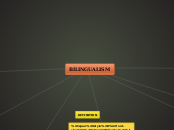• Proficiency in two or more languages. • Bilingualism is evident in reading, writing, speaking and listening. ( Anita wolfork pag 177)
DEFINITION
Bilingual education develops important cognitive skills such as problem solving, logic, critical thinking and creativity because it exercises your brain and forces you to think about how you can express and effectively convey your thoughts with the vocabulary you possess in each language. These cognitive skills are transferable across disciplines and may even be one of the reasons why being bilingual helps to delay cognitive decline and the symptoms of Alzheimer. These are also the same cognitive skills that experts and educators say are becoming increasingly important to have in order to successfully participate in our society and the workforce Bloomfield Leonard (1935)
TRANSFER
BILINGUALISM
TYPES OF PROCESS IN BECOMING BILINGUAL - ACORDING TO THE AUTHORS
LATE BILINGUALISM
Refers to bilingualism when the second language is learned after the age of 6 or 7; especially when it is learned in adolescence or adulthood
EARLY BILINGUALISM
Children who experience early and extensive exposure to both of their languages quickly grasp the fundamentals of both of their languages
SUCCESIVE EARLY BILINGUALISM
Refers to a child who has already partially acquired a first language and then learns a second language early in childhood.This generally produces a strong bilingualism (or additive bilingualism), but the child must be given time to learn the second language, because the second language is learned at the same time as the child learns to speak.Suzanne Romaine (1995: 183-205)
SIMILTANEOUS EARLY BILINGUALISM
Refers to a child who learns two languages at the same time, from birth. This generally produces a strong bilingualism, called additive bilingualism. This also implies that the child's language development is bilingual. Suzanne Romaine (1995: 183-205)
FOLK BILINGUALISNM
People who develop second language capacity under circumstances that are not often of their own choosing, and in conditions where the society does not value their native language
ELITE BILINGUALISM
SKUTNABB- KANGAS (1981)
people who choose to have bilingual home, often in order to enhance social status.
SUBSTRACTIVE BILINGUALISM
Two languages are competing rather than complementary. child is educated in the more prestigious language
ADDITIVE BILINGUALISM
(Lambert, 1975- 1977)
Both languages and the culture associated with them bring complementary positive elements to the child
BILINGUALISM VS BICULTURALISM
Just as a bilingual may have varying degrees of competence in two (or more) languages, he or she may also display different degrees of biculturalism. Normally, we can expect less fluent bilinguals to be less bicultural as well, in the same way as one would predict that a fluent bilingual will be more familiar with both cultures. But it also depends on the way the bilinguals have acquired their languages. Baetens Beardsmore (1986: 23)
WHO ARE BILINGUAL CHILDREN?
• A bilingual has full fluency in two languages. •Children can acquire two languages at the same time in early childhood and be proficient in both. • Children may also learn a second language after mastering the first to become bilingual. • It is rare for proficiency in both languages to be perfectly balanced in the child. Butler, Y. & Hakuta, K. (2004)
Be Bilingual means to be able to move between two cultures, while keeping a sense of identity. Being bilingual also means mastering the knowledge necessary to communicate within two cultures as well as face the possible discrimination. ( Anita wolfork pag 175)
Effects on the second language on the first language
SECOND LANGUAGE
FIRST LANGUAGUE
WHAT IS IT?
BILINGUALISM PATTERNS
SCHOOLING
Nowadays education can play a very important role in attempts to make our children bilingual. One of the clear examples of what one school can do for bilingual education comes in the shape of the CLV — Concordia Language Villages Summer Immersion Programme, which combines the school model of teaching and all the advantages provided by immersion into the target language environment
CLOSE CONTACT WITH OTHER LINGUISTIC GROUPS
In some multinational states or countries with rich linguistic diversity, contact between members of different language groups is quite common. The children may have parents or relatives who speak different languages, or they may hear one language at home and another one outside it. Skutnabb-Kangas (1984: 75-80)
MIGRATION
The children of migrants may grow up hearing only the language of their parents, if they live in a community composed mainly of migrants of homogeneous origin, and their contact with the second language may not begin in earnest until they are of school age. (before 1917), Belgium, Spain, Portugal
IMMIGRATION
The children of immigrants usually acquired their first language at home, from their parents and relatives, and their L2, that of their new country of residence, from people outside the home. The result was usually that, for many generations of immigrants, bilingualism was a transitory stage, lasting only a limited number of years and generations (before 1917), Belgium, Spain, Portugal
Types of Bilingualism
AMBI-BILINGUAL
Person who pases in any situation in both languages for a native speaker he or he is indistinguishable from a native speaker
BALANCE BILINGUAL
People who are more or less equally proficient in both languages, but will not necessarily pass for a native speaker in both languages.
COORDINATE BILINGUAL
When two parents have different mother tongues and each parent speaks only his or her own mother tongue to the child so the person constructs two separate linguistic systems and can handle each of them easily.
COMPOUND BILINGUAL
A person who is more proficient in one of the two languages
PASSIVE BILINGUAL
A person who is native speaker in one is capable of understanding but no speaking another language
SEMI-BILINGUAL
A person no strong in either / any language

